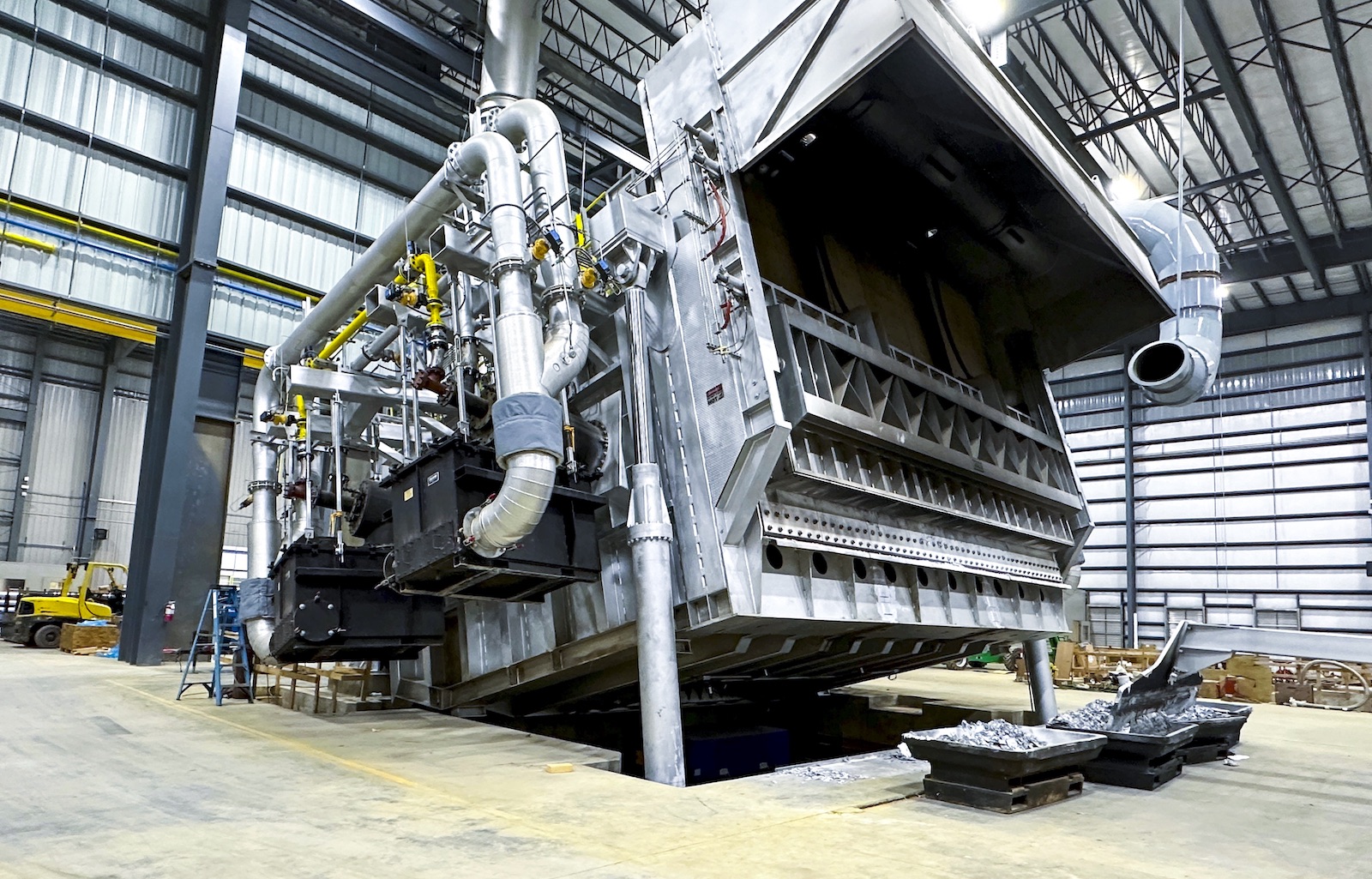
By Andrea Svendsen, Managing Editor.
Service Center Metals (SCM), an aluminum extrusion manufacturing company headquartered in Prince George, VA, is celebrating 20 years of continuous operation this year. As the company moves into its third decade, it is completing a $127 million investment in a new remelt and casting plant and new extrusion plant near its existing operations—thus continuing its path of expansion and growth. Currently, the new casthouse is up and running, with the extrusion operations to follow later this year. The simultaneous expansion enables the company to increase its capacity to meet customer demand, as well as create 94 new jobs.
Background
SCM began its operations in Prince George County in 2003, with the start up of its first 9 inch Presezzi/OMAV extrusion line, dubbed Elvis. This was followed a few years later by a second 14 inch Presezzi press in 2006, named The Boss (after Bruce Springsteen). Since then, the company has evolved into a vertically integrated aluminum billet and extrusion operation, having built and launched its compact remelt plant and casthouse in 2014. Currently, the company operates four horizontal casting lines, also named after rock ‘n’ roll icons — Mick, Keith, Jake, and Elwood.
From its two plants on its 30-acre campus in South Point Business Park, the company produces extruded rod, bars, shapes, and tubing in 6xxx series alloys (primarily 6063 and 6061), which is mainly shipped to metal service centers across the U.S. Meanwhile the casting operations enable the company to fully meet its own needs for extrusion billet, as well as consistently sell high quality billet to the North American extrusion industry.
Love for rock ‘n’ roll aside, what continues to drive SCM toward success is its people and company culture, which incorporates a “Can Do” attitude. The company defines itself by its ability to ensure the safety of its employees, achieve operational efficiency, and provide high product quality combined with excellent customer service.
When making an ownership shift in July 2019, SCM kept this company culture in mind. At the time, SCM Industries, LLC, an investment entity affiliated with The Riverstone Group in Richmond, VA, acquired the majority ownership position in SCM. This enabled the company to remain independent and stay connected to its values, while also providing new growth opportunities.
“Our new majority ownership has not only supported our growth plans, but they have also allowed us to accelerate them,” said Scott Kelley, CEO of SCM. “Part of those growth plans over the last year have included building the SCM Health Center, which is now open to all SCM employees and their families free of charge.”
SCM’s continued growth is supported by the positive trends that the company is seeing in the North American extrusion market. “The global march toward a green economy heavily favors aluminum products, such as extrusions, due to its many exceptional qualities, including aluminum’s unmatched ability to be recycled efficiently. The impact will be most directly felt in the enormous transportation and building and construction industries,” noted Kelley. “Also supporting our bullish view, the Infrastructure Investment and Jobs Act will add $550 billion in infrastructure building over the next ten years, as well as the Inflation Reduction Act, which will add $370 billion of tax incentives for clean energy investments. In my mind, the most exciting trend is ‘on shoring’ as North American manufacturers seek to gain control of their critical supply chains.”
Planning for Expansion
With the growing North American extrusion market, SCM has seen significantly increased demand, more than it had the capacity to meet, despite operating 24 hours a day and seven days a week. In addition, the company was looking into fully entering the billet market, as demand was also increasing for low-carbon, recycled billet. “We’ve been busting at the seams for some time now,” said Kelley. “On the extrusion side, we felt it was important to not only offer our existing customers more capacity, but also broaden our capabilities. From a casting perspective, we felt the time was right to offer billet with the highest recycled content in the industry, which SCM is marketing as Emerald Eco-Billet.”
For its new extrusion and casting operations, SCM decided to stay in Virginia, purchasing 70 acres of land very close to its existing facility in Prince George. The location provides the company with excellent logistics, enabling it to easily deliver its products to two-thirds of the U.S. in just a single day’s drive. In addition, the company received support from the local government, including a $350,000 grant from the Commonwealth’s Opportunity Fund and a $900,000 Virginia Investment Performance Grant.
“The Commonwealth of Virginia has a business-friendly environment and has been very supportive of our growth plans,” said Kelley. “In addition, we’re all about the Can Do culture at SCM. It’s something that’s firmly established here, and we feel strongly it would be easier to maintain that most important part of our business with our existing leadership team intact.”
The land purchase provided the company plenty of room in which to design the two new buildings for the extrusion plant and the remelt and casting plant. As this was the first time that the company was able to build the extrusion and casting operations at the same time, the project team took full advantage of the opportunity to maximize the efficiency of both.
“SCM has learned a lot in the last 20 years,” said Sam Wang, director of Engineering & IT at SCM. “We’ve grown from one to two presses and then got into the casting business, growing into the largest horizontal casting operation in North America. So, we’re quite battle tested, and we have taken from that past experience and implemented that knowledge in our new facilities. We were able to design the plants to optimize the operational flow, from receiving scrap to the casting operation, and from extrusion to the finished product and delivery to our customers.”
Starting the expansion in 2021, SCM knew that COVID-19 would likely present challenges as the project developed. However, the supply chain issues grew as the project progressed, and the company faced these challenges head on. “We were somewhat intolerant of suppliers that don’t take care of customers when times get tough,” explained Wang. “During the project, when a supplier couldn’t find parts, our people at SCM traveled around the country to find alternate sources, so the suppliers could keep working and we could stay on our timeline. That’s a part of our Can Do mentality, and we always hope that we can find suppliers who are like minded.”
New Remelt and Casting Plant
The remelt and casting plant, dubbed “Cash” (after Johnny Cash), started up operation in November 2022. Housed in an almost 250,000 sq ft building, the operation has been carefully planned to optimize material flow pathways. Post-consumer scrap material (Figure 1), along with process scrap from the extrusion plant, is received for recycling and finished billet being shipped to customers is able to flow through the plant efficiently without cross-traffic and bottlenecks. In addition, the plant was designed with future building and production line expansions in consideration, making it easy to continue to grow in the future.
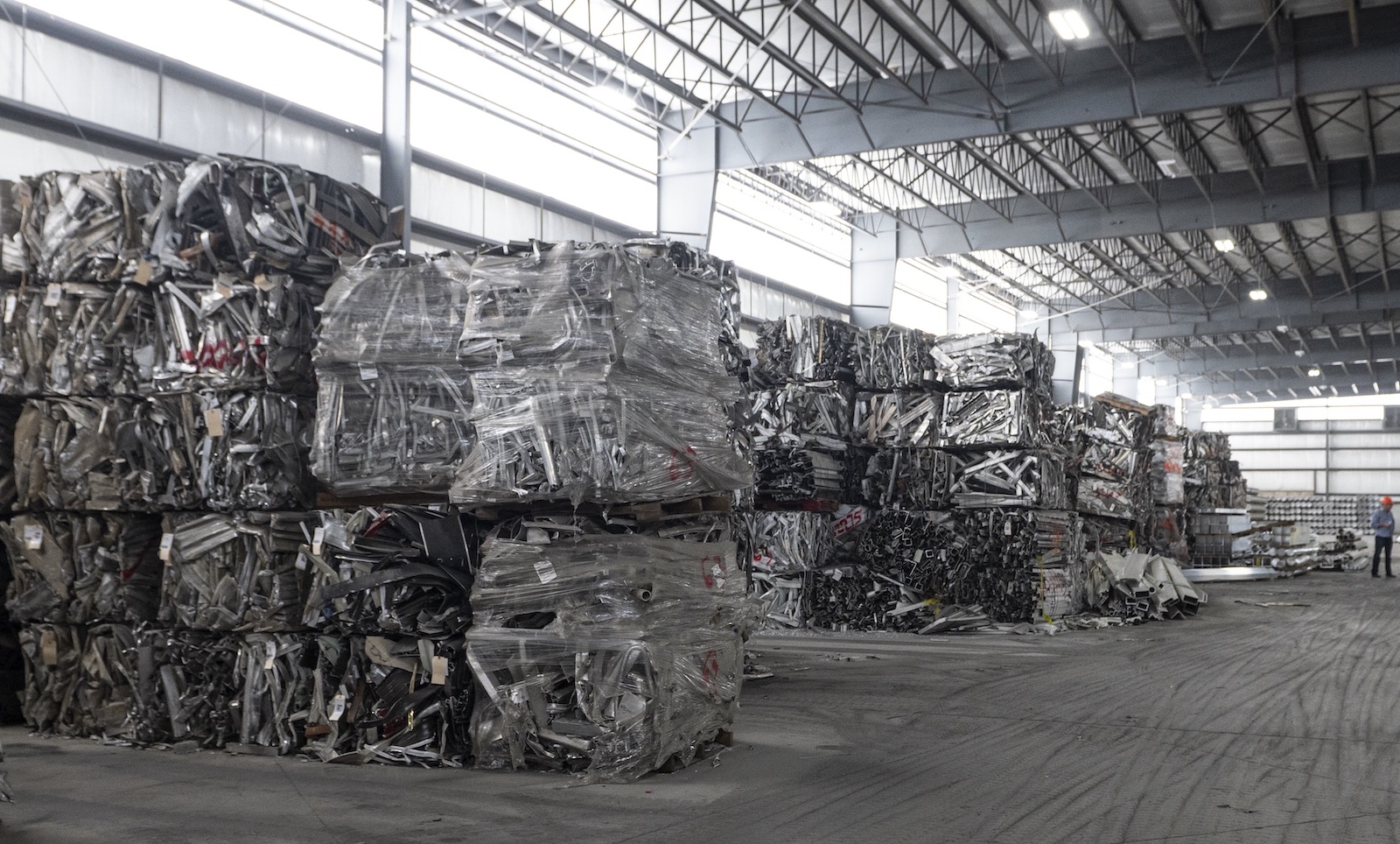
From top to bottom the remelt and casting plant is state-of-the-art with high levels of automation throughout—from hands-free casting with automated dams and camera systems to fully automated helical ultrasonic inspection, continuous homogenizing, cutting, stacking, and banding of the final product. “During the equipment selection process, we were tasked with finding the best technology and partners that would suit our needs,” said Wang. “We were in contact with many suppliers for each area of the plant, and we reviewed drawings and specifications, traveled to see their equipment in operation, and ultimately, chose the partners that could supply robust equipment and allow us to maximize production flexibility and offer the highest quality billet to our customers.”
In the remelt area, raw material is delivered in the form of scrap or primary aluminum sows. Prior to melting, the sows are processed in the preheating furnace supplied by GNA alutech, which has a 120,000 lbs capacity for each heating cycle. Preheating increases the melt rate of the sow, as well as removing the danger of moisture being trapped in the material before it is charged.
Scrap aluminum is charged directly into the two 50 tonne GNA tilting melting furnaces. The delacquering system installed on each furnace is able to remove contaminants, such as paint or organic materials, prior to melting. In addition, the delacquering system has oxygen injectors, which facilitate the elimination of VOCs inside the melter, while also controlling the O2 concentration within the main furnace. Any additional emissions from the furnaces are captured by state-of-the-art, lime-injected baghouses.
In this way, SCM can purchase cost-effective scrap from the market and directly melt it without any additional processing steps. The entire melting process is monitored via a high temperature camera installed inside the furnace, making it possible for operators to observe the entire melting process and make adjustments depending on the alloy mix.
Each melting furnace is outfitted with an ALTEK Type 500 electromagnetic stirring (EMS) system, which is fixed to a simple frame positioned under the furnace hearth, allowing the furnace to tilt above the stirrer. The EMS stirs the metal during the melting cycle to provide an increased melt rate, reduced energy consumption, improved chemical and temperature homogeneity, and reduced dross generation. The stirrer is air cooled, which means that no pipework for water cooling was required near the furnace, minimizing installation costs and increasing safety. Since different phases of the melting cycle have different requirements, the EMS features an ALTEK control system that is programmed to automatically modulate key operational parameters to maximize the performance.
Scrap and sows are charged into the furnace with an MCM 140/550 furnace charging and skimming machine from GLAMA. The machine has a gross capacity of 23,500 lbs and is driven by a Cummins diesel engine with 200 BHP. The charging machine picks up a prefilled box. Once at the furnace, the filled box is discharged via a pusher system, ensuring a fast charging operation that results in the furnace door only being open for a short time, thus saving energy. The large reach into the furnaces combined with the pushing operation and the ability of the machine to travel backward means that the charge is spread evenly through the furnace, preventing damming. In addition to charging, the same machine performs the skimming operation (Figure 2) and can also perform stirring and cleaning tasks due to its quick change attachments. In 2023, a second machine of the same design will be delivered to SCM, followed by a combi-function furnace charging and tending machine with a four-wheel steering system.
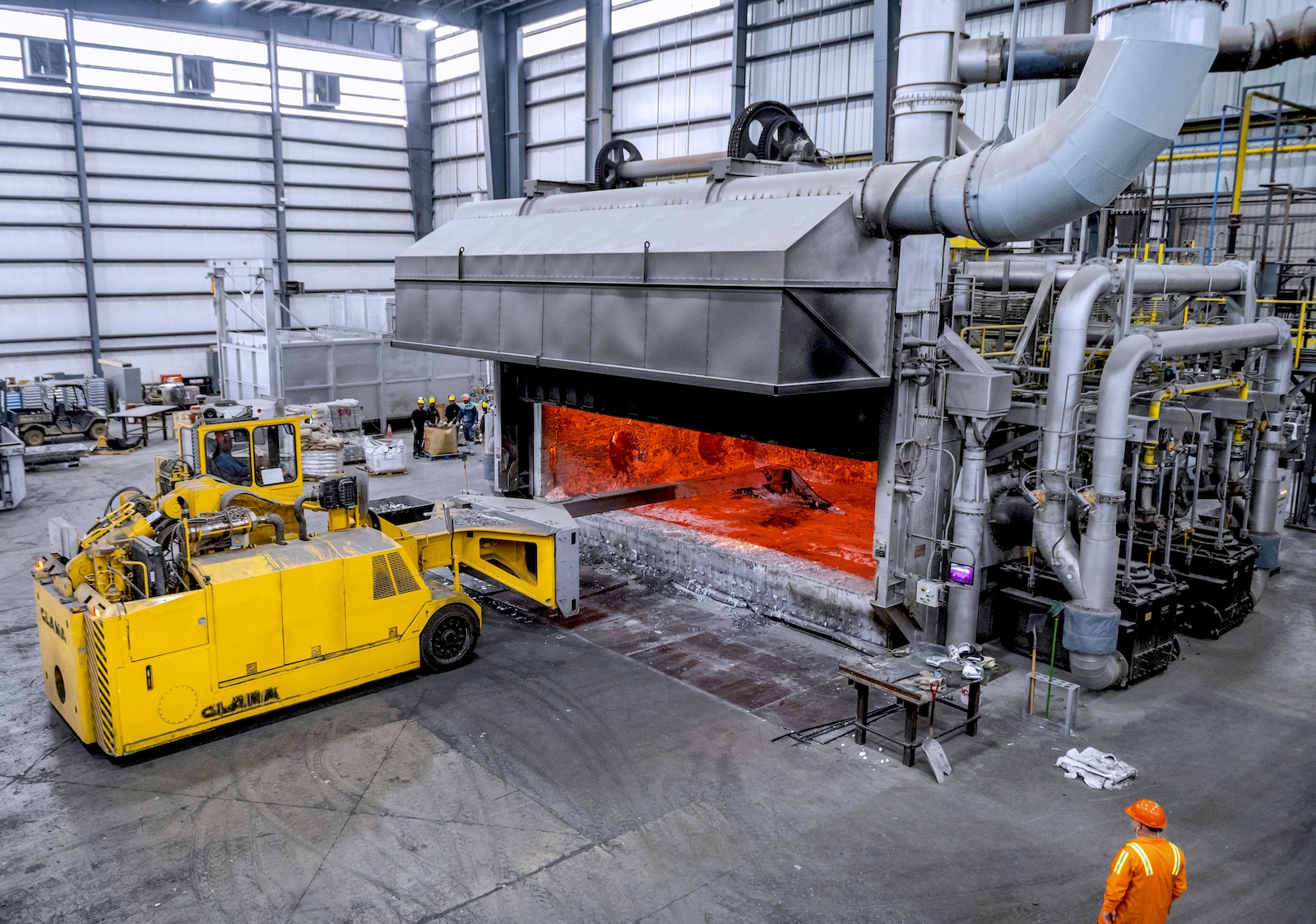
Dross that is skimmed from the furnace is collected in cast steel dross pans customized to fit the furnace sill heights and expected dross volumes. The collected dross is then delivered to an ALTEK Tardis III dross press where up to 100 tons of force is exerted on the dross to squeeze out trapped metal. The drained metal is delivered directly back into the furnace, while the left over dross goes through a cooling and compression cycle that minimizes oxidation and metal loss, allowing SCM to recover more metal when it is sent to their secondary dross recycler. In addition, this cooling and compression process minimizes fugitive emissions that occur when handling dross. The entire dross pressing process is monitored via its inbuilt control systems and online reporting dashboards.
After the melting process is completed, the furnaces tilt to provide an even, controlled flow of liquid aluminum to the vertical direct chill casting line.

Metal flows through the insulated trough system provided by Pyrotek, which connects the furnace, heated ceramic foam filter bowl, degasser, and casting table. The ceramic foam filter bowl system (also supplied by Pyrotek) features a gas-fired heated lid to provide uniform pre-heating of the filter (Figure 3-top), along with automatic drains that allow for hands-free termination of the cast. It was flexibly designed to meet both current and future metal quality requirements.
STAS supplied the ACD/Aluminium Compact Degasser®, which was integrated into the trough system (Figure 3-bottom). The multi-stage degasser with ten rotors treats the molten aluminum as it passes through the casting trough. The degasser also includes an FFD flux feeding unit, which injects very small quantities of solid flux underneath the metal surface, which are dispersed by the rotors. This assists in the removal of alkalis and inclusions, particularly the elimination of chlorine gas.
Once the metal has been treated, it is delivered to the Wagstaff ShurCast™ vertical direct chill casting machine, which supports the development of the starting head base and metal as it descends into the casting pit. Four NuMax™ billet casting molds were provided, capable of producing a cast with 88 strands of 7 and 8 inch billet, 54 strands of 9, 10, and 11 inch billet, 32 strands of 12 inch billet, and 24 strands of 14 and 16 inch billet. The NuMax molds are able to improve productivity, while also reducing maintenance time and costs. The casting machine includes a tilt system, which supports the casting tables and makes it easier for operators to perform maintenance between casts. The entire casting process is managed through an AutoCast™ automated casting control system with SCADA data collection, which operates a trough dam between the ceramic foam filters and the casting table for a hands-free cast start. The casting line also includes an automated water cooling system. “Ultimately, the greatest benefit for us is the vertical casting line, which has the best casting process,” said Kelley. “It also provides flexibility, providing us with the ability to offer more tailored alloy chemistries for our customers. We also appreciate the level of technology and automation, which allows us to achieve hands-free casting.”
After casting, the logs are laid down on a table (Figure 4), after which no personnel need to touch the logs until they are banded into bundles prior to shipping. The ultrasonic inspection, homogenizing, and sawing line supplied by Hertwich Engineering, part of SMS group, is fully automated and only requires a single operator to run. The multi-transducer, helical ultrasonic inspection system checks every single log for cracks, surface defects, and inclusions, qualifying the billet up to a Class A standard (Figure 5). The homogenizing oven and cooler has a nominal capacity of 62,000 tpy (based on 11 inch billet), and the billet saw can cut and stack various sizes of billet simultaneously.
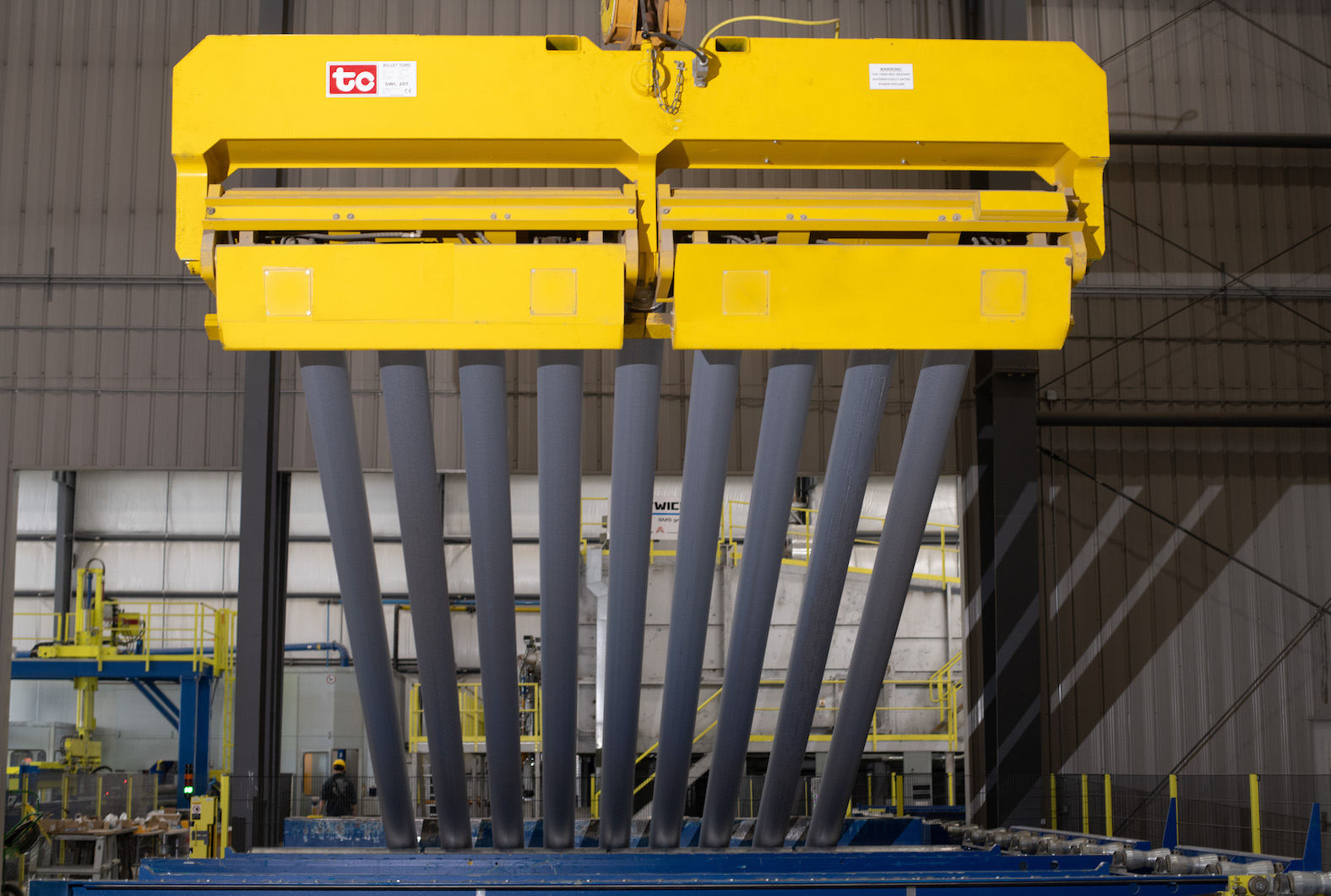
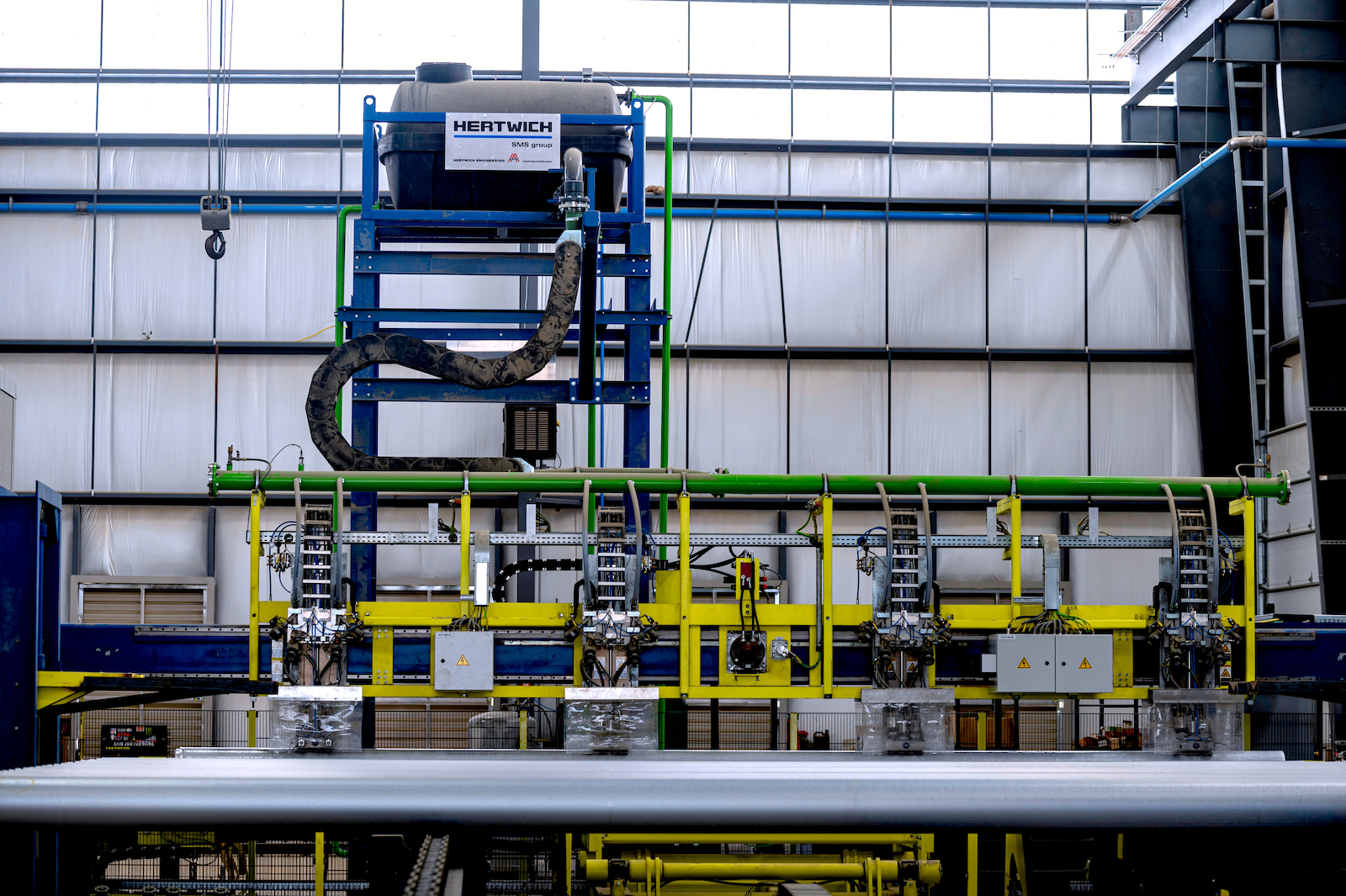
SCM began the hiring process before the casthouse was even completed, and training has been ongoing throughout construction with the participation of various supplier companies. In addition, a group of operators traveled to Spokane, WA, to receive hands-on training at Wagstaff’s casting center.
With its well-trained staff and advanced equipment technology, SCM is operating its new casthouse around the clock. The casthouse primarily produces 6xxx alloys in sizes ranging from 7 to 16 inches, with the capacity to produce 240 million lbs of billet per year. The majority of this billet (around 80%) is being sold to outside extruders in North America—particularly targeting extruders interested in sustainability with its new Emerald Eco-Billet. “We’ve dabbled in the billet market in the past, but now we are actively selling to about a dozen customers,” said Kelley. “We are also able to offer the greenest billet on the market, with 90% recycled content—the highest of any billet producer in the industry.”
Press Line Expansion
The new extrusion press line, dubbed “Jimi” (after Jimi Hendrix), is currently under construction, with SCM planning to begin operation in July of this year. Currently, the foundation has been laid for the new line within a 100,000 sq ft building, and the press is being shipped from Italy, where it was constructed within the Danieli Breda facility (Figure 6). The line will have an annual capacity of around 50 million lbs per year, once it starts operation.
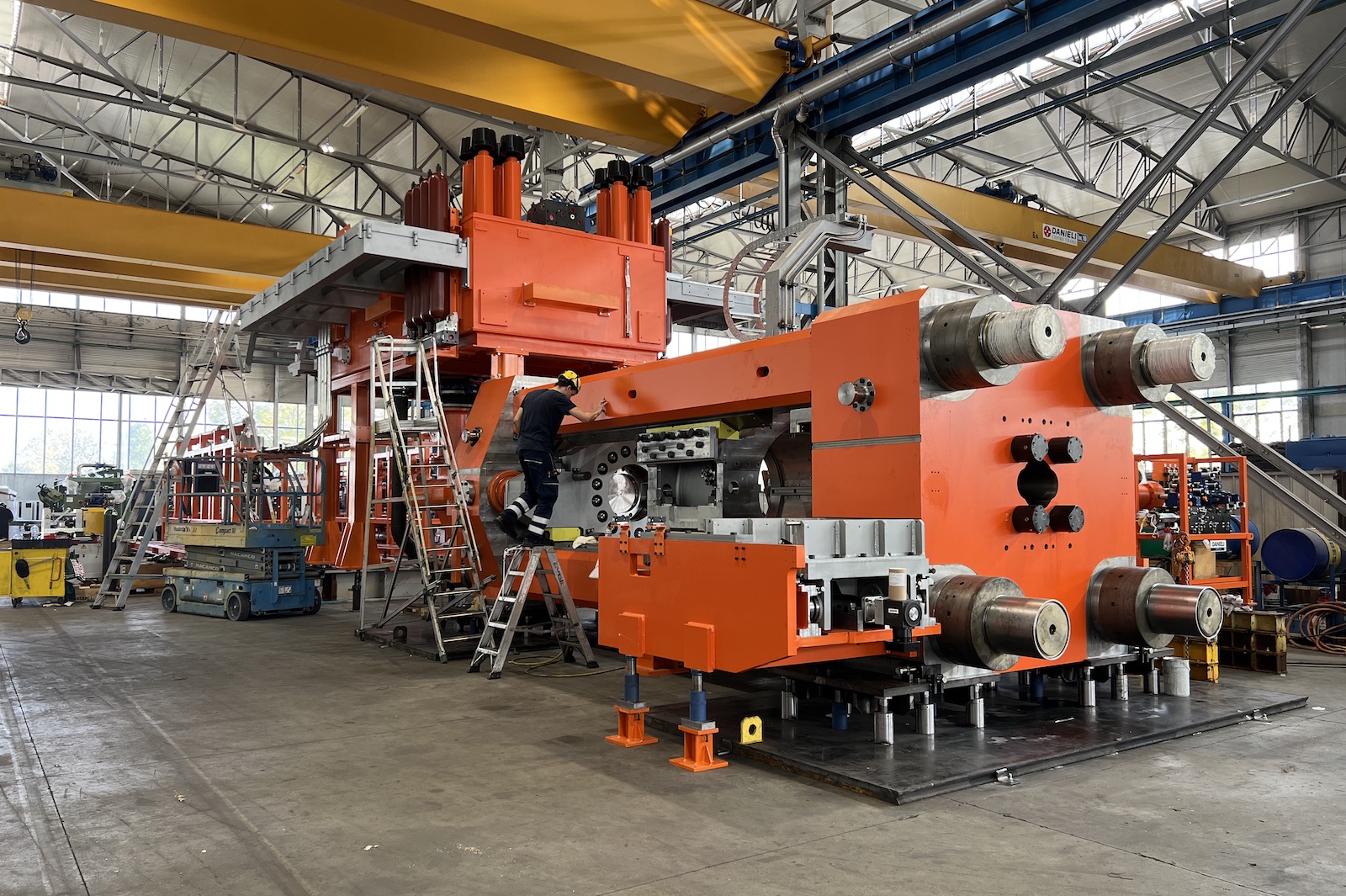
As with the casthouse, material flow, automation, and safety were key considerations when designing the press line, as is reflected by SCM’s choice of equipment suppliers. Safety systems are laid out to isolate each zone from each other throughout the line, and disconnects are located directly on the motors and devices, allowing for equipment to be shutdown quickly and lockout procedures to be easily put into effect.
At the start of the extrusion line, the billet is processed through a new 11 inch gas-fired heating furnace from COIM, part of Presezzi Extrusion Group, which also supplied a multi-level log storage system and a high-precision hot log saw. The new furnace will be able to heat up 26,000 lbs of billet per hour, with a high accuracy and homogeneity and up to 80% energy efficiency.
The 5,000 MT extrusion press from Danieli Breda has a 13 inch circle size and is able to extrude billet that is 11 inches in diameter. The press includes an advanced hydraulics system that is designed to provide power savings benefits compared to what SCM has seen in the past. In addition, the hydraulics feature a simple design that utilizes standard off-the-shelf parts and motors, which will make it easy to maintain.
“Jimi was designed to fit perfectly in the middle of our other two presses in terms of the size and product range of the profiles it can extrude,” said Kelley. “This allows for maximum flexibility for us to continue to support our customers. Additionally, Jimi has higher technical capabilities built-in that will enable us to expand our extrusion profile offerings.”
The handling system and aging center were supplied by Cometal Engineering. Following the press exit, the profiles are carried through a new-generation balance intensive quenching system (BICS), which has eight independent zones equipped with electrically rotating water spray nozzles that are able to operate together or separately. The automated water quench is able to achieve a forced convection of 300 W/m2K to 10,000 W/m2K or more. The soft water cooling technology allows the quench to cover the thermal range between air cooling and water cooling, enabling the system to be effective in obtaining specific material properties for very thin sections. “The quench is state-of-the-art,” said Kelley. “It will enable us to have precise control over cooling and will ultimately improve the quality and consistency of the product.”
Two independent overhead electrical double pullers with 3,527 lbs of pull force draw the profiles through the quench and place the cooled profiles on the cooling table. The pullers are designed to decrease scrap and increase production. Along with the pullers is a movable saw, which can work in flying cut mode or can act as a single puller, if needed. When in puller mode, the saw is able to apply a pulling force up to 3,527 lbs.
Additional equipment includes an inline automatic stenciling inkjet machine that can mark multiple profiles as they leave the quench exit, heavy duty timing belts for automated profile transport up to 34 lbs/ft, and an automatic 275 ton stretcher. The line also features a complete stacking system with an innovative lance-type design, which is able to provide fast and stable handling of heavy profiles, especially rod and bars, without the need for cranes or spacers. The profiles are stacked and directly packed into bundles, making them ready for aging or shipping. This packing area is highly optimized to increase safety, recovery, and throughput.
The automated aging center includes a longitudinal flow-aging oven, a transversal flow aging oven designed for bars and rods, and a transversal flow oven for annealing treatment. The floor-mounted ovens are designed to be loaded laterally using a automatic guided vehicle (AGV) from Cometal. The use of AGVs for the transport of bundles ensures that the floor is free of conveyors and prevents personnel from coming into contact with forklifts, thus improving safety.
Conclusion
SCM continues to grow on an impressive scale. The company’s newly completed casthouse and soon to be completed extrusion plant are evidence of its efforts to invest in new technologies designed to expand its capabilities and capacity. “We are constantly looking for opportunities to take advantage of our strengths,” said Kelley. “SCM will never stop working on ways to safely improve in all facets of our business. We are also forever in search for the best talent in the industry. We plan to stay true to our mission, which has guided us for 20 years—namely, a laser focus on safety, customer service, quality, and efficiency every single day.”
Editor’s Note: This article first appeared in the April 2023 issue of Light Metal Age. To receive the current issue, please subscribe.
